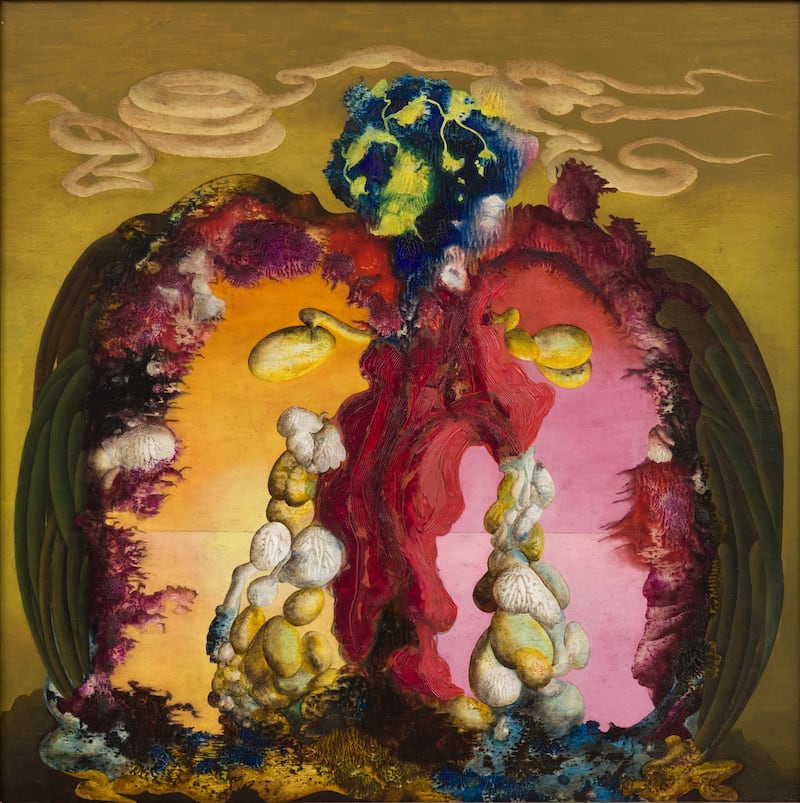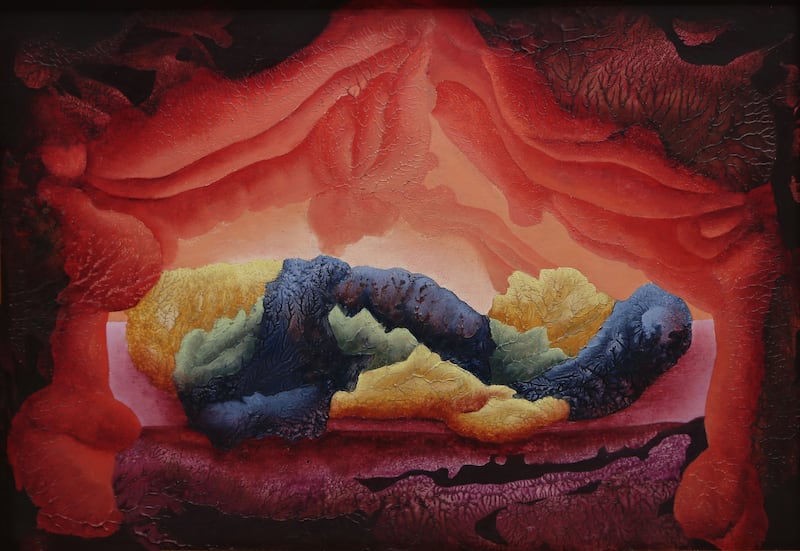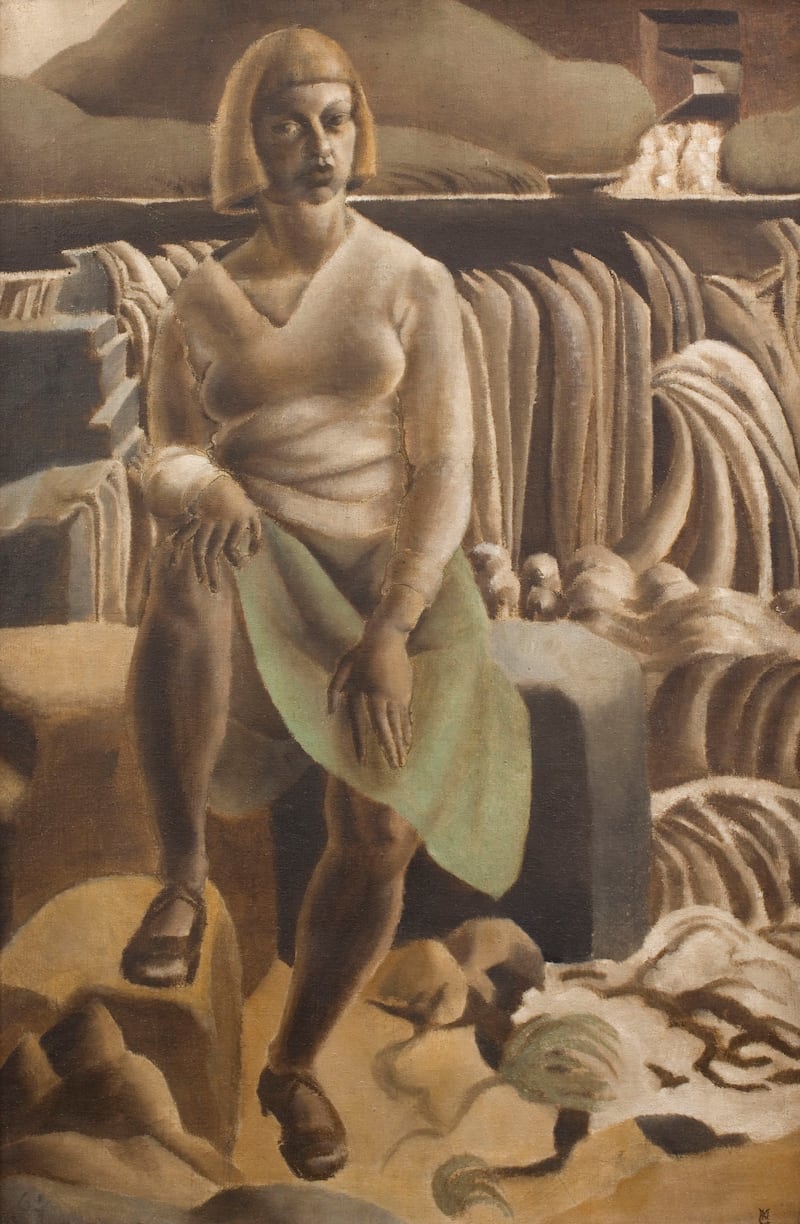Erotic, animistic, a gender-bending visual double-entendre: Ithell Colquhoun’s painting Scylla exemplifies many of the lifelong passions of its creator, “the lost surrealist”.
Stare at the artwork, which Colquhoun made in 1938, for a couple of moments and your view switches from coastal landscape to the perspective of a woman – or a giant earth goddess – in the bath. She looks towards her strangely phallic thighs, across pubic-hair seaweed beneath the bathwater; a boat is heading suggestively towards her vulva.
Then the phallic thighs morph into phallic labia, and the gender transgressing gets even more playful, demonstrating another of Colquhoun’s themes: the alchemical reconciliation of male-female binary opposites through hermaphroditic and androgynous imagery.
The British painter, who felt a far greater affinity growing up with the “Celtic fringe” than she did with English culture (and whose name is pronounced “Eye-thell Col-hoon”), is the next undervalued woman artist to be up for reappraisal – and, at last, inclusion – within mainstream international art appreciation.
READ MORE
This year, for the first time, her work is being shown to a wide audience, with a landmark retrospective under way at Tate St Ives, in Cornwall in England, that moves to Tate Britain, in London, in the summer.
Scylla is named after a monstrous sailor-eating maiden from Greek mythology. Colquhoun (who lived from 1906 to 1988) took another Greek female monster as inspiration for her painting Gorgon, from 1946. The Gorgons were three sisters – Medusa is the most famous – who had wings, snakes for hair, and a gaze that could turn men to stone.
With its sense of vast proportion, Colquhoun’s Gorgon exemplifies the original meaning of the romantic word “sublime”: she smites the viewer with awe, beauty and terror. Yet, as with Scylla, there’s a friendly feminist reclamation of this female “monstrosity”. The Gorgon seems to look to the side, so she won’t inadvertently kill us, and with her opening embrace she invites viewers to look within, across calm sunset seas, towards expansive horizons and infinity.

The paradoxical peace that emanates from this monster suggests a surrealist double meaning, in which Colquhoun mixes the Gorgon’s association with stone – egg-like lumps of which tumble from her – with the arcane concept of philosopher’s stone, the most desired achievement in the alchemy of the psyche, symbolising spiritual enlightenment: the union of the conscious and the unconscious, the human and the divine.
Colquhoun created Gorgon using decalcomania, a technique beloved of the surrealists that involves pressing together two surfaces on which ink or paint has been applied, such as paper or canvas, to create chance mirror images. Colquhoun’s decalcomania often evokes atmospheres that are billowy and otherworldly, as with her painting Alcove, from 1946.

It’s difficult not to see its fleshy pink folds as vaginal. Colquhoun exalted “the feminine divine”, which she saw everywhere in nature. Frequently in her work, she uses geological metaphors, such as caves or volcanoes, to refer to the vulva.
Our own ancestors had a penchant for this, too: the old Irish for Ballypitmave, in Co Antrim, translates as “townland of Maeve’s vulva”, while Sawel, the highest peak in the Sperrin Mountains, in Co Tyrone, comes from Samhail Phite Mhéabha, or “likeness to Maeve’s vulva”.
Colquhoun was born into a British colonial military family who had lived in northern India for several generations. When she was less than a year old she was moved to England to live with family. Her father was of Scottish descent, and her maternal grandfather was Irish.
Colquhoun visited Ireland from a young age, sketching the landscapes and megalithic sites she saw here. Two of her specifically Irish-themed paintings are The Battle Fury of Cuchulinn, a decalcomania from 1949, and Woman of Beare, created in 1950 with the surrealist technique known as frottage, in which the artist takes a rubbing from a textured surface to produce an unplanned image.
That the retrospective has opened first at Tate St Ives is significant, because the artist regarded Cornwall, that remote, ancestrally Celtic part of England, in the remote southwest, as her spiritual home, living and working there for more than half of her life.
She died in Cornwall in obscurity, in 1988, aged 81, considered something of a loner witch by the locals. With no children, she left her vast body of visual work to the National Trust.
Her memory was kept alive in Cornwall by a small group of devotees. In 2019 the National Trust gave the Tate Colquhoun’s collection of 5,000 pieces, which it had been valiantly preserving to the best of its ability in a draughty shed.
Alongside Hilma af Klint, the early-20th-century Swedish female abstract artist whose retrospective show broke the box office at the Guggenheim in New York a few years ago – and whose work predates that of Wassily Kandinsky, the figure previously regarded as the pioneer of abstract art – Colquhoun is one of the artists featured in Jennifer Higgie’s groundbreaking book The Other Side: A Journey into Women, Art and the Spirit World, from 2023.
The art historian suggests that part of the reason curators haven’t known what to do with Colquhoun is her polymathy. “That Colquhoun was such a wonderful writer perhaps deflected attention away from her artworks,” she says. “By the end of her life she had penned so many poems, esoteric essays, novels, autobiographies, biographies and cosmic travelogues – all in a style that is consistently vivid, wildly original and scholarly – that it might take a diligent reader a lifetime to absorb all she had to offer.”

Colquhoun’s books include her popular travel memoirs The Living Stones: Cornwall and The Crying of the Wind: Ireland, from the mid-1950s, as well as Goose of Hermogenes, a surrealist alchemical novel from 1961. Pushkin Press is republishing all three, in gorgeous editions, to coincide with the Tate retrospective. (Reflecting the written word’s lifelong significance to the artist, two chapters in Tate’s exhibition catalogue are dedicated to her writings and her extensive library on esoteric subjects.)
Colquhoun viewed herself as a practising magician. She committed her life to the study of occult philosophies – implying those based on hidden or secret knowledge – from the west, such as hermeticism; and from the east, such as non-dual Indian Tantra. This latter worldview and accompanying practices, including yoga, meditation and ritual, reflect the belief that all is one (not two) and that the goal of life is to perceive the connected divine in all things, including oneself.
“The story of modernity that was told from the late 1930s,” Higgie says, “was the story that modernism was about a kind of abstraction that was leaning towards something very formal. Words like spirituality, or the imagination or the occult, they would have been considered dirty words within that narrative, and in the art history that was taught for generations. Even in the 1980s and 1990s, when I was at art school, these things weren’t being accommodated within a rigorous intellectual or academic framework.
“But the revisionism of art history – one that I applaud – is accommodating the idea that all humans make art, not just white western men. This isn’t a story about closing things down; it’s not about saying those artists who were acclaimed in the past weren’t good. Many of them were brilliant and wonderful, and I continue to delight in what they achieved. But now the story is expanding to include different kinds of experiences of art, and that art has different functions for different people. It’s not a singular narrative.
“Tate have been brilliant in bringing in new narratives into the history of art,” she says. “What they’re doing is quite radical. They’ve been real champions of the achievements of female artists – including ones who weren’t necessarily in the centre of the modern discourses that were acclaimed by the art establishment over the last 50 years.”
Dr Amy Hale, a US folklorist and anthropologist, was first touched by what aficionados call “the hand of Ithell” in 2000. She was lecturing at the Institute of Cornish Studies, part of the University of Exeter, when a friend alerted her to the almost forgotten artist.
“My friend told me Colquhoun was a druid and into witchcraft, and Celtic stuff and surrealism and the occult,” Hale says. “She said that her written archives were in London, in the Tate. I went, and they hadn’t catalogued any of it yet. They wheeled out a trolley, and when I opened the first box I saw a letter to Doreen Valiente, considered the ‘mother of modern witchcraft’, and these cabbalistic drawings. The volume and significance of the material was staggering.”
Hale got to work. The result is the first in-depth biography of Colquhoun, Hale’s sumptuously illustrated Genius of the Fern Loved Gully: The Supersensual Life of Ithell Colquhoun, Artist and Occultist, published in 2020.
Her examination of the magical and cultural confluences shaping the imagination and artistic vision of Colquhoun, whom she considers one of the 20th century’s most important occultists, breaks new ground, resonating with the surge of interest in occulture generally, and in the ever clearer understanding of the influential role of occult ideas in the history of art. Over the past 10 years, a burgeoning number of art books and exhibitions testify to this influence internationally.
Last year Tate published an illustrated book, edited by Hale, called Sex Magic: Ithell Colquhoun’s Diagrams of Love, exploring the artist’s often highly explicit “magical erotic corpus” of sacred sexual painting and poetry, some of which makes its way into this year’s Tate exhibitions. Colquhoun was bisexual, and took lovers; radically, she believed that female sexual pleasure and the empowerment of women were keys to enlightenment and apotheosis.
Hale writes that “it is very likely that Colquhoun’s interest in sex magic as an engine of social transformation” was inspired by her close readings of A Vision, “the challenging revelatory text channelled by WB Yeats and his wife, Georgie”.
Hale conjectures that the sexual preoccupations of Yeats’s later years prompted Colquhoun’s “diagrams of love” project. “Colquhoun met Yeats in 1937,” she says. “His influence on her magical and artistic projects can’t be overestimated. In many ways Yeats’s work provides a template for Colquhoun’s pursuits throughout her life.”
[ Unthinkable: His poetry’s great but could WB Yeats think straight?Opens in new window ]
Colquhoun never stopped referring to herself as a surrealist. Both in her visual and her written work, she continued to use surrealist techniques of chance and “automatism”, such as decalcomania, to bypass her “rational” mind and to access her unconscious and what she viewed as the spirit world. “But now,” Hale says, “Colquhoun is no longer the ‘lost surrealist’. She’s being rediscovered as a mystic, and as an esoteric artist.”
Ithell Colquhoun: Between Worlds is at Tate St Ives, in Cornwall, until May 5th; the paintings will be shown at Tate Britain, in London, from June 12th to October 19th; ithellcolquhoun.co.uk














